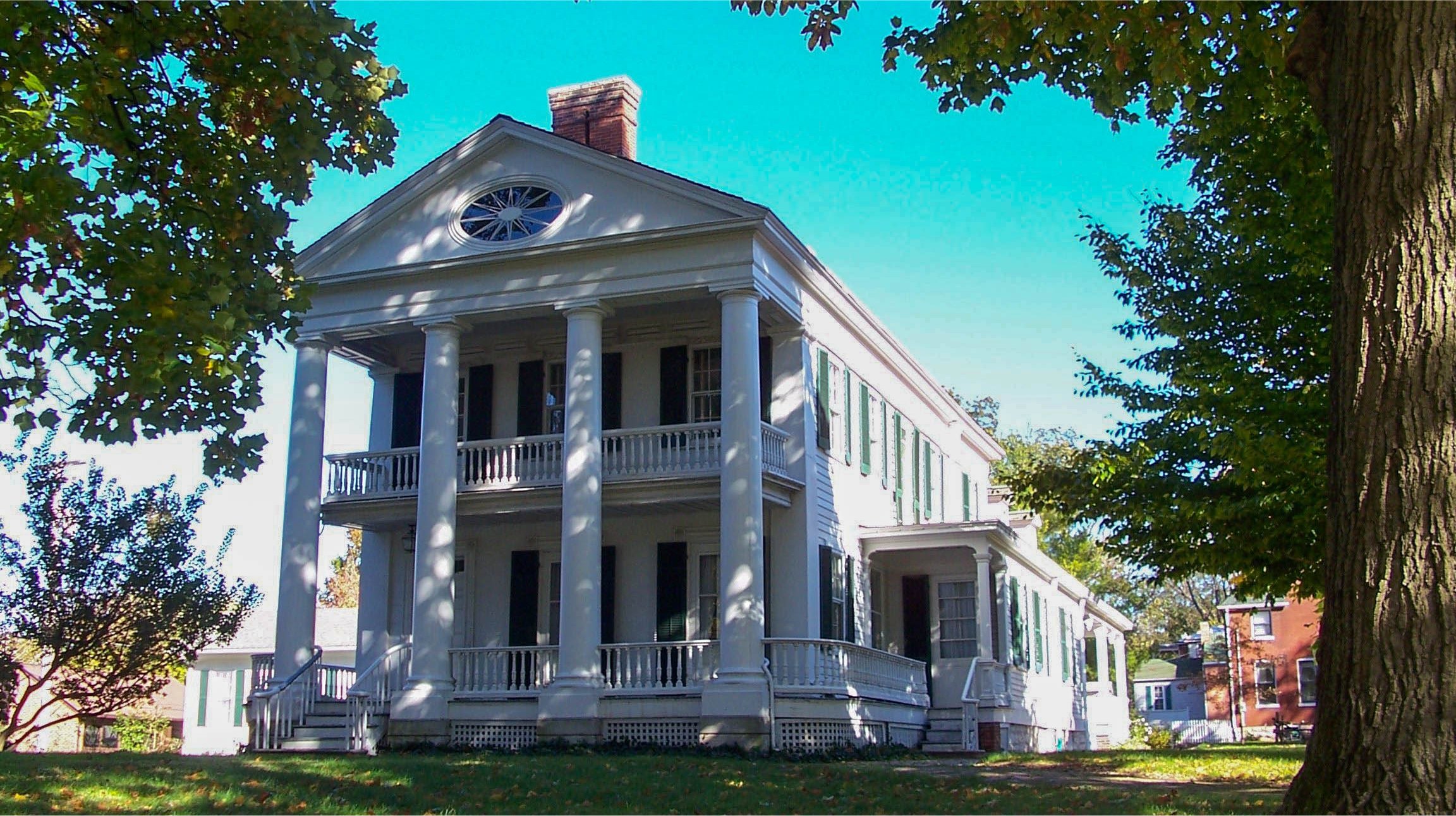425 South 12th Street
Quincy, Illinois
217-222-1835
John Wood was born in New York in 1798 and at the age of 20 decided to go west, settling in Atlas, which is about 40 miles south of Quincy, where he started to farm. The land between the Illinois and Mississippi River was part of the Illinois Military Tract, which was land given to veterans who had fought in the War of 1812. In 1822 Woods met a Mr. Flinn, a soldier who had received 160 acres, and accompanied Flinn as he travelled north to locate his land. Upon reaching his tract Flinn decided he did not want to live so far from St. Louis and agreed to sell the land to Wood for $60.00 or about 38 cents an acre. Wood built his first house, a log cabin near the river, at the foot of what is now Delaware Street, becoming the first European settler in the area. Other settlers came from the East to claim their land grants or to engage in trade, and the land around Wood’s cabin became a small settlement that became known as Bluffs because of its location. When Adams County was formed in 1825, Bluffs was chosen as its county seat and renamed Quincy after the new President of the United States, John Quincy Adams. John Wood married Ann Streeter in 1826 and built a two-story log cabin at 12th & State Street. Wood was becoming wealthy by acquiring land that veterans did not want and selling it to settlers coming from Kentucky and Tennessee. In 1835 he started building a large 14 room Greek Revival style house next to the log cabin. The home was completed in 1838 and used German immigrants who were skilled at carpentry, bricklaying, and stone masonry that he brought from St. Louis and New Orleans.
John Wood was popular and was elected mayor of Quincy three different times. In 1856, he was elected Lt. Governor of Illinois in one of the first victories by the newly formed Republican Party. In 1858 Wood began construction on an even larger house, an octagonal structure, in the middle of the block of State Street between 11th & 12th. In March of 1860 Governor William H. Bissell died in office and Wood became the 12th Governor of Illinois. Wood successfully petitioned the Illinois Legislature to stay in Quincy to oversee the construction of the octagonal home and the existing mansion temporarily became the Governor’s Mansion. Wood was Governor for only ten months as he did not seek re-election in November of 1860 because of commitments in Quincy. When the Civil War broke out in 1861 Wood was named Quartermaster General of the State of Illinois and in 1863 he became Colonel of the 137th Illinois Volunteer Infantry Regiment. 1863 was also the year that Ann, his wife of 37 years, died and Wood married Mary Ann Holmes. John and Ann Wood had had eight children, but only four of them lived to adulthood – a daughter and three sons.
Wood’s octagonal home was completed in 1864 and cost over $200,000 to build, making it the most expensive home in Illinois at the time. With the octagonal house completed Wood gave the Greek Revival style house to his oldest son, Daniel. Wood wanted it moved to the east side of 12th Street and the house was cut in half and the chimneys were taken down so the house could be moved across the street. Originally the house faced the south to take advantage of the summer breezes as was the norm for Greek Revival style houses. When the house was moved, the foundation was placed so the house now faces the west. The Panic of 1873 started a period of economic crisis for the American economy. This a severe nationwide economic depression, which lasted until 1879, affected the fortunes of Wood. In 1875 creditors wanted payment for the unpaid bills on the octagonal home and Wood was forced to sell the house for $40,000. He moved back into the mansion, sharing it with his son Daniel, until his death in 1880. John Wood is interred at the Woodland Cemetery in Quincy.
After Wood’s death, Daniel sold the mansion and moved to Galena, Kansas. The house became a boarding house with many different families living in its various rooms. In 1906 the Historical Society of Quincy and Adams County purchased the house to save it from destruction from businessmen who wanted to tear it down. At first they used it as a museum with many people going through it. Unfortunately, they did not have the money to maintain it very well and by the early 1970’s the house was in disrepair. At that time, the Historical Society decided to restore the house to its original look. To date over $500,000 has been spent on restoring the house. Visitors can tour this magnificent home that is furnished with period pieces, some of which belonged to John Wood himself. The John Wood Mansion was added to the National Register of Historic Places in 1970.
The Parsonage is a 2-story brick house that was built in 1885 to serve as the minister’s home for the English Lutheran Church, which later became Luther Memorial Church. The red entrance and red doors symbolize the house’s historical connection with the church. The Parsonage now serves as a museum of the Historical Society with exhibits showcasing items from Adams County’s past including the Civil War, early founders, education and fine arts, industry, agriculture, pharmacies and medicine, steamboats, railroads, circuses, and a major doll collection. One Adams County township is featured annually in a rotating display with items depicting its history. The adjoining log cabin was relocated from Perry, Missouri, after it was donated by a local attorney whose family owned the land that the cabin sat on. The log cabin is now used as an educational facility for third grade students during the fall and features garden featuring plants grown by a typical 19th-century pioneer family.
The Library and Visitors Center houses the Historical Society headquarters, its historical library, and audio visual and group meeting room. The extensive library features many important books and documents on early life in Quincy and Adams County. These include city directories, city and county histories, and other original resources for research. The Osage Orangerie Museum Store is located in the Visitors Center and offers Quincy souvenirs and original hand-crafted selections from local artisans reminiscent of the 19th century.
Visiting the John Wood Mansion, 1835 Log Cabin, and Parsonage
Visiting Hours
Monday - Saturday: 10 am - 2 pm
Parsonage open year round, Mansion closed November through March
The Library and office are only open Monday - Friday
The Log Cabin is not open to tours to the general public
Admission
Explore the community of Quincy














